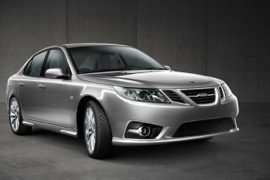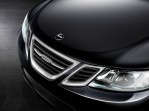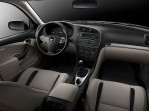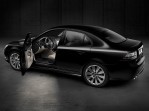Segment: Medium
Production years: 2014, 2015, 2016, 2017, 2018, 2019, 2020, 2021, 2022, 2023, 2024
 8 Photos
8 PhotosDescendants of the mighty Vikings, the Swedish people, didn't want to let SAAB die and tried to revive it after the GM era and produced a limited run for the 9-3 Aero in 2013-2014.
After GM sold the Swedish brand in 2009 due to the world financial crisis, the carmaker traded hands a few times before being bought by the National Electric Vehicle Sweden AB in 2012. The new owner had the rights for the brand name but not for the Griffin logo, which belonged to Scania AB. It could produce the 9-3 Aero as well, and that's what it did. But since the car didn't meet the European legislation required for a new car, it had to build just 1,000 units for the old continent. NEVC planned to export the rest of the vehicles in China, where the rules were laxer.
The 9-3 Aero featured a slightly changed front fascia, with the SAAB lettering instead of its traditional round badge with the griffin. On the lower part of the bumper, a trapezoidal grille with a mesh design covered most of the apron flanked by two side scoops for the fog lights, with a satin-gray surrounding. A set of silver trims adorned the upper grille. A set of turbine-blade style, 18" light-alloy wheels confirmed the car's sporty character from its sides. At the back, a dual exhaust peaked out under the bumper.
Inside, SAAB engineers designed and installed new, bolstered bucket seats. More silver trims enhanced the black and tan dashboard look and surrounded the instrument cluster, which was extended over the center stack. These were the main differences compared to the 9-3 Aero from the GM era.
Under the hood, NEVC bought the engines from GM, which used the same powerplant in the Insignia. But, unlike the European sedan, the 9-3 Aero provided just 220 horses, 30 less than the Opel's mid-size vehicle.
SAAB 9-3 Aero 2014, 2015, 2016, 2017, 2018, 2019, 2020, 2021, 2022, 2023, 2024
- 2.0L 6AT FWD (220 HP)
- 2.0L 6MT FWD (220 HP)
SAAB 9-3 Aero
2.0L 6AT FWD (220 HP)
ENGINE SPECS - 2.0L 6AT FWD (220 HP) | |
|---|---|
| Cylinders: | L4 |
| Displacement: | 1998 cm3 |
| Power: | 162 KW @ 5300 RPM 220 HP @ 5300 RPM 217 BHP @ 5300 RPM |
| Torque: | 258 lb-ft @ 2000-4000 RPM 350 Nm @ 2000-4000 RPM |
| Fuel System: | Turbocharged Direct Injection |
| Fuel: | Gasoline |
PERFORMANCE SPECS | |
|---|---|
| Top Speed: | 146 mph (235 km/h) |
| Acceleration 0-62 Mph (0-100 kph): | 8.6 s |
TRANSMISSION SPECS | |
|---|---|
| Drive Type: | Front Wheel Drive |
| Gearbox: | 6-speed automatic |
BRAKES SPECS | |
|---|---|
| Front: | Ventilated Discs |
| Rear: | Ventilated Discs |
TIRES SPECS | |
|---|---|
| Tire Size: | 225/45 R18 |
DIMENSIONS | |
|---|---|
| Length: | 183.8 in (4669 mm) |
| Width: | 80.2 in (2037 mm) |
| Height: | 57.1 in (1450 mm) |
| Wheelbase: | 105.3 in (2675 mm) |
| Cargo Volume: | 16.3 cuFT (462 L) |
WEIGHT SPECS | |
|---|---|
| Unladen Weight: | 3571 lbs (1620 kg) |
| Gross Weight Limit: | 4409 lbs (2000 kg) |
FUEL ECONOMY (NEDC) | |
|---|---|
| City: | 18.4 mpg US (12.8 L/100Km) |
| Highway: | 39.2 mpg US (6 L/100Km) |
| Combined: | 27.7 mpg US (8.5 L/100Km) |
| CO2 Emissions: | 195 g/km |
SAAB 9-3 Aero
2.0L 6MT FWD (220 HP)
ENGINE SPECS - 2.0L 6MT FWD (220 HP) | |
|---|---|
| Cylinders: | L4 |
| Displacement: | 1998 cm3 |
| Power: | 162 KW @ 5300 RPM 220 HP @ 5300 RPM 217 BHP @ 5300 RPM |
| Torque: | 258 lb-ft @ 2000-4000 RPM 350 Nm @ 2000-4000 RPM |
| Fuel System: | Turbocharged Direct Injection |
| Fuel: | Gasoline |
PERFORMANCE SPECS | |
|---|---|
| Top Speed: | 149 mph (240 km/h) |
| Acceleration 0-62 Mph (0-100 kph): | 6.9 s |
TRANSMISSION SPECS | |
|---|---|
| Drive Type: | Front Wheel Drive |
| Gearbox: | 6-speed manual |
BRAKES SPECS | |
|---|---|
| Front: | Ventilated Discs |
| Rear: | Ventilated Discs |
TIRES SPECS | |
|---|---|
| Tire Size: | 225/45 R18 |
DIMENSIONS | |
|---|---|
| Length: | 183.8 in (4669 mm) |
| Width: | 80.2 in (2037 mm) |
| Height: | 57.1 in (1450 mm) |
| Wheelbase: | 105.3 in (2675 mm) |
| Cargo Volume: | 16.3 cuFT (462 L) |
WEIGHT SPECS | |
|---|---|
| Unladen Weight: | 3483 lbs (1580 kg) |
| Gross Weight Limit: | 4376 lbs (1985 kg) |
FUEL ECONOMY (NEDC) | |
|---|---|
| City: | 21 mpg US (11.2 L/100Km) |
| Highway: | 45.2 mpg US (5.2 L/100Km) |
| Combined: | 31.8 mpg US (7.4 L/100Km) |
| CO2 Emissions: | 170 g/km |







